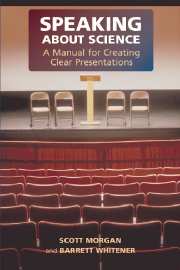Book contents
- Frontmatter
- Contents
- ACKNOWLEDGMENTS
- INTRODUCTION
- 1 THE BASIC PROBLEM WITH ORAL PRESENTATIONS, AND ITS SOLUTION
- 2 THE FIRST STEPS OF PREPARATION
- 3 SELECTING HELPFUL IMAGES
- 4 BEGINNING AND ENDING THE PRESENTATION
- 5 TITLING THE TALK
- AT A GLANCE: THE SEVEN SIGNPOSTS
- AT A GLANCE: 15 KEYS FOR SUCCESS BEHIND THE PODIUM
- 8 THE JOB INTERVIEW
- 9 THE MEDIA INTERVIEW
- 10 MAKING CLEAR POSTERS
- IN CLOSING
- APPENDIX 1 FULL INTRODUCTIONS
- APPENDIX 2 POSTERS
- Index
10 - MAKING CLEAR POSTERS
Published online by Cambridge University Press: 04 August 2010
- Frontmatter
- Contents
- ACKNOWLEDGMENTS
- INTRODUCTION
- 1 THE BASIC PROBLEM WITH ORAL PRESENTATIONS, AND ITS SOLUTION
- 2 THE FIRST STEPS OF PREPARATION
- 3 SELECTING HELPFUL IMAGES
- 4 BEGINNING AND ENDING THE PRESENTATION
- 5 TITLING THE TALK
- AT A GLANCE: THE SEVEN SIGNPOSTS
- AT A GLANCE: 15 KEYS FOR SUCCESS BEHIND THE PODIUM
- 8 THE JOB INTERVIEW
- 9 THE MEDIA INTERVIEW
- 10 MAKING CLEAR POSTERS
- IN CLOSING
- APPENDIX 1 FULL INTRODUCTIONS
- APPENDIX 2 POSTERS
- Index
Summary
It is the weight, not the number of experiments that is to be regarded.
– Sir Isaac NewtonAs irresistible as it may be for a speaker to pack a lot of information into a short talk, the temptation is equally great when creating a poster. A presenter may think that a poster's modest dimensions cannot hold nearly enough data to explain her research. Her tendency, then, is to reduce the font of the text and the size of the images to compensate for the poster's spatial limits. The result is a forbiddingly detailed poster that few people will bother to examine. If a major challenge with a talk is time, then that for a poster is space.
Before tackling this spatial challenge, it is worth considering a poster's primary purpose: to facilitate networking with those in attendance. It should act as a springboard for interaction with other scientists, potential employers and peers. A poster can also open avenues for future discussion, thereby building personal and professional connections long after the poster session has ended. The success of a poster depends on how well it accomplishes these goals.
Organizing a Poster
A poster should attract the attention and curiosity of passersby, enticing them to stop and investigate further. Yet a poster cannot stand alone. Once it draws attention, the presenter is then in charge of illuminating its contents. Therefore, the function of the poster is to support the presenter's verbal description.
- Type
- Chapter
- Information
- Speaking about ScienceA Manual for Creating Clear Presentations, pp. 105 - 110Publisher: Cambridge University PressPrint publication year: 2006

